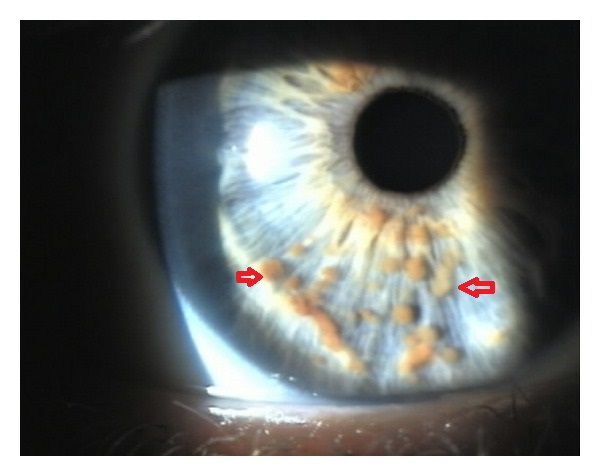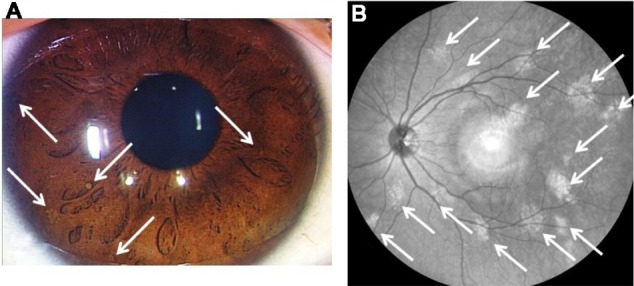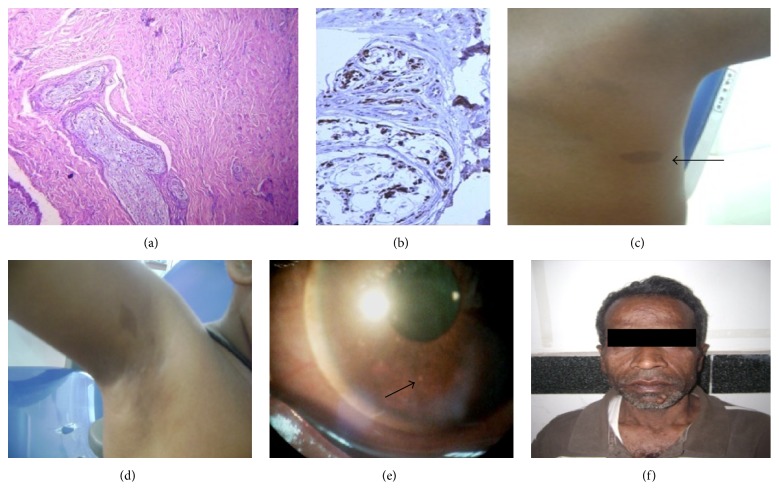Lisch nodule
Editor-In-Chief: C. Michael Gibson, M.S., M.D. [1]; Associate Editor(s)-in-Chief: Swathi Venkatesan, M.B.B.S.[2]
Synonyms and keywords: Sakurai-lisch nodule
Overview
Lisch nodules are well defined melanocytic hamartomas of the iris. Lisch nodules generally appear as dome-shaped gelatinous masses. Lisch nodules masses are more commonly develop on the surface of the iris, also known as iris hamartomas. Lisch nodules are gold-tan to brown in color, they may grow up to 2 mm in diameter and can be of different sizes on the same iris. Lisch nodules arise from mast cells, pigmented cells and fibroblast-like cells. The presence of Lisch nodules is the most common clinical sign of Neurofibromatosis 1; ninety-three percent of cases are bilaterally affected and an average of 25 nodules can be counted on each iris. Once iris hamartomas have developed, they remain stable throughout life. In 80% of eyes, Lisch nodules may be found in the inferior quadrants of the iris and this may be related to greater sun exposure, one of the postulated factors in the development of these benign tumefactions.
Historical Perspective

Multiple small, oval, yellow-brown papules (Lisch nodules) in the right iris(Red arrows). case courtesy by E. G. Adams et al.[1] - NF is a neuroectodermal abnormality constituted by a set of clinical symptoms that compromise the skin, nervous system, bones, eyes and other sites.
- Lisch Nodules were named after the infamous Austrian ophthalmologist Karl Lisch(1907-1999) who was also called as "Ophthalmological Pope".
- Besides general ophthalmology, Lisch was interested in scientific research. He published more than 120 scientific papers in German science journals.
- In 1937, Karl Lisch published an article on the iris hamartomas and their association with neurofibromatosis 1, now known as "Lisch nodules", while at the University Eye Clinic in Munich.
- Lisch'a article described his observations in 3 patients with neurofibromatosis:[4][5]
- Patient 1: A 39 year old male who had been affected with several nodules and pigmented lesions on the skin, typical of neurofibromatosis, since the age of 15 years. His mother and his sisters had a similar disorder. Lisch observed several brown nodules on the surface of the iris. The nodules could be seen even without the slit lamp due to the greyish-blue color of the iris.
- Patient 2: 27 year old patient with similar cutaneous and iris lesions could be detected along with a family history of neurofibromatosis. In comparison to the first patient the iris nodules were much more pigmented.
- Patient 3: A 44 year old male suffered form bilateral optic nerve gliomas with chiasmal involvement. The slit lamp examination revealed tiny iris nodules in both eyes.
Classification
- There is no established system for the classification of Lisch nodules.
Pathophysiology
- A hamartoma is defined as a benign tumor or nodular growth that is composed of proliferating mature histologically normal cells that normally reside at the affected tissue.[6][7][8][9]
- NF1 is due to mutations in the NF1 gene, located at chromosome 17q11.2.[10][11]
- Lisch nodules are generally not present in central NF(neurofibromatosis)/NF(neurofibromatosis)-2.
- Neurofibromin, the protein product encoded by the gene, is expressed in many tissues, including brain, kidney, spleen, and thymus.
- Mutations in the NF1 gene result in loss of production or reduced function of protein; this causes a wide spectrum of clinical findings, including NF1-associated tumors.[12][13]
- Histopathologically, Lisch nodules are composed of melanocytes and spindle cells, usually concentrated on the superficial layers of the iris stroma.[14][15][16]
- The spindle cells are larger than the normal iris melanocytes.
- Immunohistochemical studies show positive reaction against the following
- Vimentin
- Smooth muscle actin
- Neuron specific enolase.
Causes
- Lisch Nodules commonly associated with neurofibromatosis and is caused by genetic defects or mutations that either are passed on by a parent or occur spontaneously at conception.
Differential diagnosis
- Lisch nodules must be differentiated from Iris mammillations, Iridocorneal endothelial syndrome, Rieger's anomaly or syndrome, Iris nevi, Melanoma, Inflammatory conditions such as Sarcoidosis, Leprosy, Tuberculosis and Syphilis.[17][18]
Epidemiology and Demographics
Incidence
- The incidence of Lisch nodules is approximately 1 in 2600 to 3000 individuals worldwide.[19][20]
- Approximately one-half of the cases are familial (inherited).[21][22]
- The remainder are the result of de novo (sporadic) mutations.
Prevalence
- The prevalence of Lisch nodules is approximately 1 in 3500 individuals worldwide.[23]
Age
- Lisch nodules are predominantly visible in children usually after the age of six years.[24]
- Lisch Nodule incidence in NF1 increases with age and their prevalence raises by about 10% per year of life, up to age 9.
- Lisch nodules are found in 93% of adults with NF-1 but have not been described in NF-2.
- Lisch Nodules may be found in a very limited number of individuals without NF.
- The de novo mutations occur primarily in paternally derived chromosomes, and the likelihood of de novo NF1 increases with advanced paternal age.
Risk Factors
- The biggest risk factor for Lisch nodules associated with neurofibromatosis is a family history of the disorder.
Screening
- Lisch Nodules are not regularly screened, they’re usually detected when other signs and symptoms of neurofibromatosis appear.[25]
Natural History, Complications and Prognosis
Natural History
- The symptoms of Lisch Nodules usually develop in the first decade of life, and mostly asymptomatic.
Complications
- Common complications of Lisch Nodules include:[27][28]
- Optic gliomas
- Pseudarthrosis
- Progressive vision loss
- Choroid hamartomas
- Retinal tumors
- Prominent corneal nerves
Prognosis
- Prognosis is generally good of patients with Lisch Nodules.
Diagnosis
Diagnostic Criteria for neurofibromatosis 1
- (National Institute of Health Consensus Development Conference 1988)[29][30][31][32][33][34][35][36]
- 6 or more café au lait macules[37]
- Cafe au lait macules should be >0.5 cm in length in children
- Cafe au lait macules should be >1.5 cm in length in adults
- 2 or more cutaneous neurofibromas or one plexiform neurofibroma
- Axillary or groin freckling
- Optic gliomas
- 2 or more Lisch nodules especially iris hamartomas which can be seen on slit lamp examination
- Bony dysplasia with or without pseudarthrosis
- First degree relative with NF1
- 6 or more café au lait macules[37]
- The diagnosis is primarily based on clinical assessment and two or more of the features are required to confirm the diagnosis.
Physical Examination

Lisch nodules and near-infrared reflectance image (case 4). At least five Lisch nodules were detected and were classified as scale III (A). Note that 14 bright, patchy lesions were detected by near-infrared reflectance (B). The hyper-reflective point at the center of the image is an optical artifact. Case courtesy by Shinji Makino et al[38] - Eye-findings include orange-brown colored specks.
- Lisch nodules are usually elevated and tan in appearance.
- Lisch nodules are benign hamartomas that can be seen without magnification.
- Also known as melanocytic hamartomas of the iris, often associated with neurofibromatosis (NF) I.[45]
- Other associated ophthalmologic findings are optic gliomas.
- Optic gliomas can alter color vision and can produce progressive vision loss.
Diagnostic Studies
- On slit-lamp examination, they have a smooth, dome-shaped appearance and are usually light brown, although some can be very pale.[46][47][48][49]
- Slit lamp examination can differentiate them from nevi on the iris by demonstrating elevated lesion instead of flat ones.[50]
- Lisch nodules develop during childhood, after the appearance of café-au-lait spots but before peripheral neurofibromas.

(a) Microsection showing bundles of wavy spindle cells with serpentine nuclei in fascicles (H&E, ×10x), (b) Strong S-100 positivity of tumor cells (×40x), (c) café au lait macule (arrow) in the back, (d) axillary freckle, (e) Lisch nodule (arrow) in slit-lamp examination, and (f) father of patient with multiple cutaneous neurofibromas. Case courtesy by Rachna Rath et al.[51]
Treatment
Medical Therapy
- There is no treatment for the underlying disease nor any necessity to treat these small benign lesions which do not interfere with visual function.[54]
- Lifelong monitoring is necessary because of the widespread manifestations and serious threat of complications such as:
- Visual impairment
- Renal hypertension
- Ischemia of major organs.
Primary Prevention
- There are no established measures for the primary prevention of Lisch nodules.
Secondary Prevention
- There are no established measures for the secondary prevention of Lisch nodules.
References
- ↑ "Multiple, Unilateral Lisch Nodules in the Absence of Other Manifestations of Neurofibromatosis Type 1".
- ↑ Antônio JR, Goloni-Bertollo EM, Trídico LA (2013). "Neurofibromatosis: chronological history and current issues". An Bras Dermatol. 88 (3): 329–43. doi:10.1590/abd1806-4841.20132125. PMC 3754363. PMID 23793209.
- ↑ Hosoi, Kiyoshi (1931). "MULTIPLE NEUROFIBROMATOSIS (von RECKLINGHAUSEN'S DISEASE)". Archives of Surgery. 22 (2): 258. doi:10.1001/archsurg.1931.01160020081004. ISSN 0272-5533.
- ↑ Gabhane SK, Kotwal MN, Bobhate SK (2010). "Segmental neurofibromatosis: a report of 3 cases". Indian J Dermatol. 55 (1): 105–8. doi:10.4103/0019-5154.60366. PMC 2856359. PMID 20418991.
- ↑ Dimitrova, Valentina (2009). "A CASE OF NEUROFIBROMATOSIS TYPE 1". Journal of IMAB - Annual Proceeding (Scientific Papers). 14, 1 (2008): 63–67. doi:10.5272/jimab.14-1-2010.63. ISSN 1312-773X.
- ↑ Terzi YK, Oguzkan-Balci S, Anlar B, Aysun S, Guran S, Ayter S (2009). "Reproductive decisions after prenatal diagnosis in neurofibromatosis type 1: importance of genetic counseling". Genet Couns. 20 (2): 195–202. PMID 19650418.
- ↑ Boley S, Sloan JL, Pemov A, Stewart DR (2009). "A quantitative assessment of the burden and distribution of Lisch nodules in adults with neurofibromatosis type 1". Invest Ophthalmol Vis Sci. 50 (11): 5035–43. doi:10.1167/iovs.09-3650. PMC 2883270. PMID 19516012.
- ↑ Boyd KP, Korf BR, Theos A (2009). "Neurofibromatosis type 1". J Am Acad Dermatol. 61 (1): 1–14, quiz 15-6. doi:10.1016/j.jaad.2008.12.051. PMC 2716546. PMID 19539839.
- ↑ Theos, Amy; Korf, Bruce R. (2006). "Pathophysiology of Neurofibromatosis Type 1". Annals of Internal Medicine. 144 (11): 842. doi:10.7326/0003-4819-144-11-200606060-00010. ISSN 0003-4819.
- ↑ Cohen R, Shuper A (2010). "[Developmental manifestation in children with neurofibromatosis type 1]". Harefuah. 149 (1): 49–52, 61. PMID 20422842.
- ↑ de Goede-Bolder A, Cnossen MH, Dooijes D, van den Ouweland AM, Niermeijer MF (2001). "[From gene to disease; neurofibromatosis type 1]". Ned Tijdschr Geneeskd. 145 (36): 1736–8. PMID 11572174.
- ↑ Lubs, Marie-Louise E.; Bauer, Mislen S.; Formas, Maria E.; Djokic, Borivoje (1991). "Lisch Nodules in Neurofibromatosis Type 1". New England Journal of Medicine. 324 (18): 1264–1266. doi:10.1056/NEJM199105023241807. ISSN 0028-4793.
- ↑ Dimitrova, Valentina (2009). "A CASE OF NEUROFIBROMATOSIS TYPE 1". Journal of IMAB - Annual Proceeding (Scientific Papers). 14, 1 (2008): 63–67. doi:10.5272/jimab.14-1-2010.63. ISSN 1312-773X.
- ↑ Abaloun Y, Ajhoun Y (2017). "[Lisch nodule in neurofibromatosis type 1]". Pan Afr Med J. 27: 218. doi:10.11604/pamj.2017.27.218.11517. PMC 5622834. PMID 28979620.
- ↑ Richetta A, Giustini S, Recupero SM, Pezza M, Carlomagno V, Amoruso G; et al. (2004). "Lisch nodules of the iris in neurofibromatosis type 1". J Eur Acad Dermatol Venereol. 18 (3): 342–4. doi:10.1111/j.1468-3083.2004.00915.x. PMID 15096151.
- ↑ Richetta, A; Giustini, S; Recupero, SM; Pezza, M; Carlomagno, V; Amoruso, G; Calvieri, S (2004). "Lisch nodules of the iris in neurofibromatosis type 1". Journal of the European Academy of Dermatology and Venereology. 18 (3): 342–344. doi:10.1111/j.1468-3083.2004.00915.x. ISSN 0926-9959.
- ↑ Radius RL, Herschler J (1980). "Histopathology in the iris-nevus (Cogan-Reese) syndrome". Am J Ophthalmol. 89 (6): 780–6. doi:10.1016/0002-9394(80)90165-8. PMID 6992584.
- ↑ Makley TA, Kapetansky FM (1988). "Iris nevus syndrome". Ann Ophthalmol. 20 (8): 311–5. PMID 3190109.
- ↑ Lubs, Marie-Louise E.; Bauer, Mislen S.; Formas, Maria E.; Djokic, Borivoje (1991). "Lisch Nodules in Neurofibromatosis Type 1". New England Journal of Medicine. 324 (18): 1264–1266. doi:10.1056/NEJM199105023241807. ISSN 0028-4793.
- ↑ Terzi YK, Oguzkan-Balci S, Anlar B, Aysun S, Guran S, Ayter S (2009). "Reproductive decisions after prenatal diagnosis in neurofibromatosis type 1: importance of genetic counseling". Genet Couns. 20 (2): 195–202. PMID 19650418.
- ↑ Evans DG, Howard E, Giblin C, Clancy T, Spencer H, Huson SM; et al. (2010). "Birth incidence and prevalence of tumor-prone syndromes: estimates from a UK family genetic register service". Am J Med Genet A. 152A (2): 327–32. doi:10.1002/ajmg.a.33139. PMID 20082463.
- ↑ Richetta A, Giustini S, Recupero SM, Pezza M, Carlomagno V, Amoruso G; et al. (2004). "Lisch nodules of the iris in neurofibromatosis type 1". J Eur Acad Dermatol Venereol. 18 (3): 342–4. doi:10.1111/j.1468-3083.2004.00915.x. PMID 15096151.
- ↑ Lammert M, Friedman JM, Kluwe L, Mautner VF (2005). "Prevalence of neurofibromatosis 1 in German children at elementary school enrollment". Arch Dermatol. 141 (1): 71–4. doi:10.1001/archderm.141.1.71. PMID 15655144.
- ↑ Cohen R, Shuper A (2010). "[Developmental manifestation in children with neurofibromatosis type 1]". Harefuah. 149 (1): 49–52, 61. PMID 20422842.
- ↑ Lubs, Marie-Louise E.; Bauer, Mislen S.; Formas, Maria E.; Djokic, Borivoje (1991). "Lisch Nodules in Neurofibromatosis Type 1". New England Journal of Medicine. 324 (18): 1264–1266. doi:10.1056/NEJM199105023241807. ISSN 0028-4793.
- ↑ Huson S, Jones D, Beck L (1987). "Ophthalmic manifestations of neurofibromatosis". Br J Ophthalmol. 71 (3): 235–8. doi:10.1136/bjo.71.3.235. PMC 1041127. PMID 3103673.
- ↑ Richetta A, Giustini S, Recupero SM, Pezza M, Carlomagno V, Amoruso G; et al. (2004). "Lisch nodules of the iris in neurofibromatosis type 1". J Eur Acad Dermatol Venereol. 18 (3): 342–4. doi:10.1111/j.1468-3083.2004.00915.x. PMID 15096151.
- ↑ Dimitrova, Valentina (2009). "A CASE OF NEUROFIBROMATOSIS TYPE 1". Journal of IMAB - Annual Proceeding (Scientific Papers). 14, 1 (2008): 63–67. doi:10.5272/jimab.14-1-2010.63. ISSN 1312-773X.
- ↑ Lewis RA, Riccardi VM (1981). "Von Recklinghausen neurofibromatosis. Incidence of iris hamartomata". Ophthalmology. 88 (4): 348–54. doi:10.1016/s0161-6420(81)35034-9. PMID 6789269.
- ↑ Huson S, Jones D, Beck L (1987). "Ophthalmic manifestations of neurofibromatosis". Br J Ophthalmol. 71 (3): 235–8. doi:10.1136/bjo.71.3.235. PMC 1041127. PMID 3103673.
- ↑ Abaloun Y, Ajhoun Y (2017). "[Lisch nodule in neurofibromatosis type 1]". Pan Afr Med J. 27: 218. doi:10.11604/pamj.2017.27.218.11517. PMC 5622834. PMID 28979620.
- ↑ Flüeler U, Boltshauser E, Kilchhofer A (1986). "Iris hamartomata as diagnostic criterion in neurofibromatosis". Neuropediatrics. 17 (4): 183–5. doi:10.1055/s-2008-1052525. PMID 3100979.
- ↑ Cohen R, Shuper A (2010). "[Developmental manifestation in children with neurofibromatosis type 1]". Harefuah. 149 (1): 49–52, 61. PMID 20422842.
- ↑ Sabol Z, Kipke-Sabol L (2005). "[Neurofibromatosis type 1 (von Recklinghausen's disease or peripheral neurofibromatosis): from phenotype to gene]". Lijec Vjesn. 127 (11–12): 303–11. PMID 16583938.
- ↑ Yang CC, Happle R, Chao SC, Yu-Yun Lee J, Chen W (2008). "Giant café-au-lait macule in neurofibromatosis 1: a type 2 segmental manifestation of neurofibromatosis 1?". J Am Acad Dermatol. 58 (3): 493–7. doi:10.1016/j.jaad.2007.03.013. PMID 18280349.
- ↑ de Goede-Bolder A, Cnossen MH, Dooijes D, van den Ouweland AM, Niermeijer MF (2001). "[From gene to disease; neurofibromatosis type 1]". Ned Tijdschr Geneeskd. 145 (36): 1736–8. PMID 11572174.
- ↑ Terzi YK, Oguzkan-Balci S, Anlar B, Aysun S, Guran S, Ayter S (2009). "Reproductive decisions after prenatal diagnosis in neurofibromatosis type 1: importance of genetic counseling". Genet Couns. 20 (2): 195–202. PMID 19650418.
- ↑ "Correlations between choroidal abnormalities, Lisch nodules, and age in patients with neurofibromatosis type 1".
- ↑ Lewis RA, Riccardi VM (1981). "Von Recklinghausen neurofibromatosis. Incidence of iris hamartomata". Ophthalmology. 88 (4): 348–54. doi:10.1016/s0161-6420(81)35034-9. PMID 6789269.
- ↑ Huson S, Jones D, Beck L (1987). "Ophthalmic manifestations of neurofibromatosis". Br J Ophthalmol. 71 (3): 235–8. doi:10.1136/bjo.71.3.235. PMC 1041127. PMID 3103673.
- ↑ Abaloun Y, Ajhoun Y (2017). "[Lisch nodule in neurofibromatosis type 1]". Pan Afr Med J. 27: 218. doi:10.11604/pamj.2017.27.218.11517. PMC 5622834. PMID 28979620.
- ↑ Yang CC, Happle R, Chao SC, Yu-Yun Lee J, Chen W (2008). "Giant café-au-lait macule in neurofibromatosis 1: a type 2 segmental manifestation of neurofibromatosis 1?". J Am Acad Dermatol. 58 (3): 493–7. doi:10.1016/j.jaad.2007.03.013. PMID 18280349.
- ↑ Cohen R, Shuper A (2010). "[Developmental manifestation in children with neurofibromatosis type 1]". Harefuah. 149 (1): 49–52, 61. PMID 20422842.
- ↑ Dimitrova, Valentina (2009). "A CASE OF NEUROFIBROMATOSIS TYPE 1". Journal of IMAB - Annual Proceeding (Scientific Papers). 14, 1 (2008): 63–67. doi:10.5272/jimab.14-1-2010.63. ISSN 1312-773X.
- ↑ Nichols JC, Amato JE, Chung SM (2003). "Characteristics of Lisch nodules in patients with neurofibromatosis type 1". J Pediatr Ophthalmol Strabismus. 40 (5): 293–6. PMID 14560838.
- ↑ Lewis RA, Riccardi VM (1981). "Von Recklinghausen neurofibromatosis. Incidence of iris hamartomata". Ophthalmology. 88 (4): 348–54. doi:10.1016/s0161-6420(81)35034-9. PMID 6789269.
- ↑ Huson S, Jones D, Beck L (1987). "Ophthalmic manifestations of neurofibromatosis". Br J Ophthalmol. 71 (3): 235–8. doi:10.1136/bjo.71.3.235. PMC 1041127. PMID 3103673.
- ↑ Abaloun Y, Ajhoun Y (2017). "[Lisch nodule in neurofibromatosis type 1]". Pan Afr Med J. 27: 218. doi:10.11604/pamj.2017.27.218.11517. PMC 5622834. PMID 28979620.
- ↑ Cohen R, Shuper A (2010). "[Developmental manifestation in children with neurofibromatosis type 1]". Harefuah. 149 (1): 49–52, 61. PMID 20422842.
- ↑ Crişan M, Talu S, Florea M, Coprean D, Cosgarea R, Crişan D (2008). "[Lisch nodules. Markers for a non-invasive diagnosis in Recklinghausen neurofibromatosis]". Oftalmologia. 52 (4): 56–61. PMID 19354164.
- ↑ "Multifocal Head and Neck Neurofibromas with Osseous Abnormalities and Muscular Hypoplasia in a Child with Neurofibromatosis: Type I".
- ↑ Yang CC, Happle R, Chao SC, Yu-Yun Lee J, Chen W (2008). "Giant café-au-lait macule in neurofibromatosis 1: a type 2 segmental manifestation of neurofibromatosis 1?". J Am Acad Dermatol. 58 (3): 493–7. doi:10.1016/j.jaad.2007.03.013. PMID 18280349.
- ↑ Terzi YK, Oguzkan-Balci S, Anlar B, Aysun S, Guran S, Ayter S (2009). "Reproductive decisions after prenatal diagnosis in neurofibromatosis type 1: importance of genetic counseling". Genet Couns. 20 (2): 195–202. PMID 19650418.
- ↑ Dimitrova, Valentina (2009). "A CASE OF NEUROFIBROMATOSIS TYPE 1". Journal of IMAB - Annual Proceeding (Scientific Papers). 14, 1 (2008): 63–67. doi:10.5272/jimab.14-1-2010.63. ISSN 1312-773X.